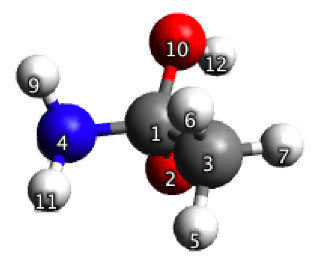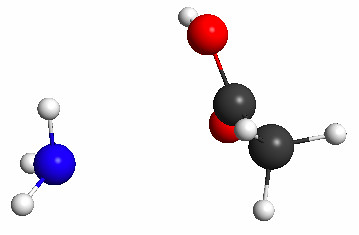This screencast shows a Molecular Workbench simulation I made to illustrate the connection between entropy, volume, and temperature.
Each simulation runs for 50 picoseconds (ps) and records how much time the two particles spend together (as a dimer) and apart (as monomers). These times are a reflection of the relative probabilities of the dimer (pdimer) and monomers (pmonomers).
In the first simulation of the screencast the particles spend 38.3 ps together and 11.7 ps apart. When I double the volume (while keeping the temperature constant) in the second simulation, the particles spend 32.7 ps together and 17.3 ps apart.
This makes intuitive sense: when the particles are not together they have a harder time finding each other again in a bigger volume. Put another way, the probability is lower that the particles find each other when they move in a larger volume.
Now I want to connect this intuitive explanation with a thermodynamic one (i.e. an explanation in terms of free energy and entropy) :
The relative probability of being together and apart is given by the change in free energy (ΔA) on going from the dimer to the two monomers (dimer -> 2 monomers)
The increase in pmonomers/pdimer (from 0.31 to 0.53) on doubling the volume must mean that ΔA decreases when the volume is doubled. Statistical mechanics tells us that the only thermodynamic term in A that is affected by volume (V) is the translational entropy
and that an increase in volume will increase the entropy of a particle
So when the volume is doubled the entropy of each particle (the dimer and each monomer) is increased by Rln(2). As a result ΔS for the reaction dimer -> 2 monomers increases [by Rln(2)] and ΔA = ΔU - TΔS decreases by RTln(2). So the probability of the dimer relative to the monomers decrease because the entropy is increased when the volume increases.
In the last simulation of the screencast I double the temperature (while keeping the volume constant) compared to the first simulation. As a result the particles now spend less time together (19.2 ps) than apart (30.8 ps).
This also makes intuitive sense: the dimer is more likely to be struck by a particle with a kinetic energy larger than the potential energy that is holding it together: Furthermore, when the monomers happen to collide they are more likely to have a combined kinetic that is larger than the potential energy holding the dimer together, i.e. "with too much kinetic energy to stick together".
As before, this must mean that ΔA decreases when the temperature is increased. The increase in translational entropy due to temperature is indeed larger than for the volume
and consistent with the observed larger change in the time the particles spend apart.
If you think of the dimer as a crude model of a salt you want to dissolve, this explains why dilution (increasing the volume) or heating increases the solubility (the amount you can dissolve). Conversely, increasing the concentration (the amount of particles per volume) or decreasing the temperature helps dimer formation and, in a larger sense, self assembly.
You can play around with it on this web page, or you can download the model if you have Molecular Workbench installed on your computer. Enjoy!
Clarifications and approximations
You may wonder why I discuss the Helmholtz free energy change (ΔA; some books use ΔF) rather than the Gibbs free energy change, when the volume changes. This is because the volume of the system (i.e. the two compartments) does not change. Another argument is that no work is done during the expansion.
I have implicitly invoked the ergodic hypothesis which states that the probability computed using a collection of molecules at a single instant in time is equal to the probability computed for a single molecule over a long period of time. While it makes intuitive sense, I don't believe this has been rigorously proven.
Related blog posts
Illustrating entropy
Where does the ln come from in S = k ln(W)?













